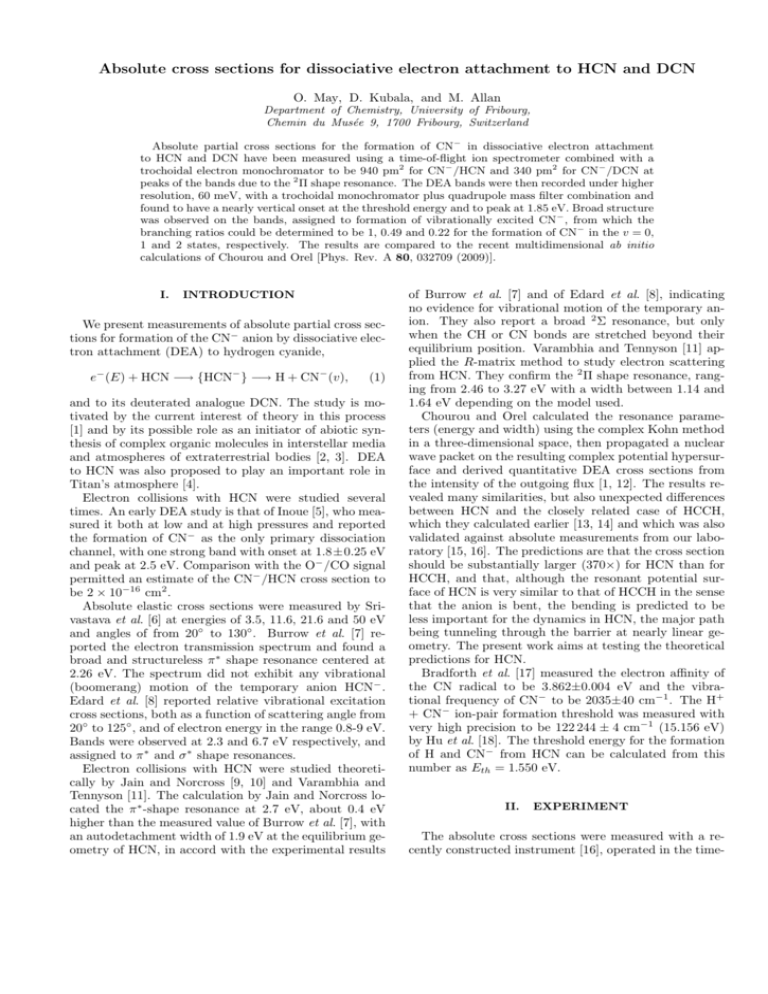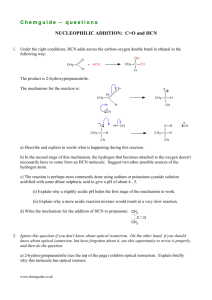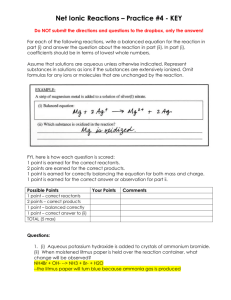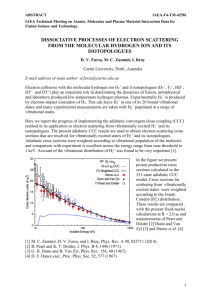Absolute cross sections for dissociative electron attachment to HCN
advertisement

Absolute cross sections for dissociative electron attachment to HCN and DCN
O. May, D. Kubala, and M. Allan
Department of Chemistry, University of Fribourg,
Chemin du Musée 9, 1700 Fribourg, Switzerland
Absolute partial cross sections for the formation of CN− in dissociative electron attachment
to HCN and DCN have been measured using a time-of-flight ion spectrometer combined with a
trochoidal electron monochromator to be 940 pm2 for CN− /HCN and 340 pm2 for CN− /DCN at
peaks of the bands due to the 2 Π shape resonance. The DEA bands were then recorded under higher
resolution, 60 meV, with a trochoidal monochromator plus quadrupole mass filter combination and
found to have a nearly vertical onset at the threshold energy and to peak at 1.85 eV. Broad structure
was observed on the bands, assigned to formation of vibrationally excited CN− , from which the
branching ratios could be determined to be 1, 0.49 and 0.22 for the formation of CN− in the v = 0,
1 and 2 states, respectively. The results are compared to the recent multidimensional ab initio
calculations of Chourou and Orel [Phys. Rev. A 80, 032709 (2009)].
I.
INTRODUCTION
We present measurements of absolute partial cross sections for formation of the CN− anion by dissociative electron attachment (DEA) to hydrogen cyanide,
e− (E) + HCN −→ {HCN− } −→ H + CN− (v),
(1)
and to its deuterated analogue DCN. The study is motivated by the current interest of theory in this process
[1] and by its possible role as an initiator of abiotic synthesis of complex organic molecules in interstellar media
and atmospheres of extraterrestrial bodies [2, 3]. DEA
to HCN was also proposed to play an important role in
Titan’s atmosphere [4].
Electron collisions with HCN were studied several
times. An early DEA study is that of Inoue [5], who measured it both at low and at high pressures and reported
the formation of CN− as the only primary dissociation
channel, with one strong band with onset at 1.8±0.25 eV
and peak at 2.5 eV. Comparison with the O− /CO signal
permitted an estimate of the CN− /HCN cross section to
be 2 × 10−16 cm2 .
Absolute elastic cross sections were measured by Srivastava et al. [6] at energies of 3.5, 11.6, 21.6 and 50 eV
and angles of from 20◦ to 130◦ . Burrow et al. [7] reported the electron transmission spectrum and found a
broad and structureless π ∗ shape resonance centered at
2.26 eV. The spectrum did not exhibit any vibrational
(boomerang) motion of the temporary anion HCN− .
Edard et al. [8] reported relative vibrational excitation
cross sections, both as a function of scattering angle from
20◦ to 125◦ , and of electron energy in the range 0.8-9 eV.
Bands were observed at 2.3 and 6.7 eV respectively, and
assigned to π ∗ and σ ∗ shape resonances.
Electron collisions with HCN were studied theoretically by Jain and Norcross [9, 10] and Varambhia and
Tennyson [11]. The calculation by Jain and Norcross located the π ∗ -shape resonance at 2.7 eV, about 0.4 eV
higher than the measured value of Burrow et al. [7], with
an autodetachment width of 1.9 eV at the equilibrium geometry of HCN, in accord with the experimental results
of Burrow et al. [7] and of Edard et al. [8], indicating
no evidence for vibrational motion of the temporary anion. They also report a broad 2 Σ resonance, but only
when the CH or CN bonds are stretched beyond their
equilibrium position. Varambhia and Tennyson [11] applied the R-matrix method to study electron scattering
from HCN. They confirm the 2 Π shape resonance, ranging from 2.46 to 3.27 eV with a width between 1.14 and
1.64 eV depending on the model used.
Chourou and Orel calculated the resonance parameters (energy and width) using the complex Kohn method
in a three-dimensional space, then propagated a nuclear
wave packet on the resulting complex potential hypersurface and derived quantitative DEA cross sections from
the intensity of the outgoing flux [1, 12]. The results revealed many similarities, but also unexpected differences
between HCN and the closely related case of HCCH,
which they calculated earlier [13, 14] and which was also
validated against absolute measurements from our laboratory [15, 16]. The predictions are that the cross section
should be substantially larger (370×) for HCN than for
HCCH, and that, although the resonant potential surface of HCN is very similar to that of HCCH in the sense
that the anion is bent, the bending is predicted to be
less important for the dynamics in HCN, the major path
being tunneling through the barrier at nearly linear geometry. The present work aims at testing the theoretical
predictions for HCN.
Bradforth et al. [17] measured the electron affinity of
the CN radical to be 3.862±0.004 eV and the vibrational frequency of CN− to be 2035±40 cm−1 . The H+
+ CN− ion-pair formation threshold was measured with
very high precision to be 122 244 ± 4 cm−1 (15.156 eV)
by Hu et al. [18]. The threshold energy for the formation
of H and CN− from HCN can be calculated from this
number as Eth = 1.550 eV.
II.
EXPERIMENT
The absolute cross sections were measured with a recently constructed instrument [16], operated in the time-
2
of-flight (TOF) mode. In this instrument a short (200
ns) pulse of electrons is sent through a target chamber
with a quasistationary sample gas at a temperature of
333 K. A 4 µs long pulse with an amplitude of -300 V,
applied to a repeller about 200 ns later, sends the anions into a TOF tube through a slit in the wall of the
target chamber. The experiment is repeated at a rate
of 20 kHz. The TOF tube consists of a three-cylinder
electrostatic lens, which images the ion exit slit onto the
MCP detector (anion impact energy 3 keV). The pressure in the collision chamber is measured by a capacitance manometer and was kept typically in the range
(1-6)×10−4 mbar. The electron beam current was typically 20-80 nA (measured without pulsing) and the resolution 200 meV. The absolute calibration was against
the 4.4 eV band of O− production from CO2 , for which
the cross section of 14.0 pm2 was used as in our previous
work. The setup was repeatedly verified by measuring
the DEA cross sections for O− formation from N2 O. The
results, 21 individual measurements for HCN and 18 measurements for DCN, agreed within a standard deviation
of 9.8% for HCN and 11% for DCN. The error of the
present relative measurement is thus taken as ±20% for
HCN and ±25% for DCN, and has to be combined with
the error of the absolute O− /CO2 cross section used for
normalization. The latter is taken as ±15% and this results in an error bar (two standard deviations) estimate
of ±25% for HCN and ±30% for DCN.
Higher resolution (60 meV) spectra were obtained
by recording relative spectra with a trochoidal electron
monochromator and a quadrupole mass spectrometer
(QMS) [19, 20] and normalizing them to the absolute
values measured by the TOF experiment. In this instrument ions created by DEA in a target chamber, at a
temperature of 358 K, are drawn out through a hole in
the target chamber by a three element lens and focused
onto a QMS. The base pressure of the apparatus was
about 5 × 10−7 mbar, sample gas pressure in the target
chamber was around 1 × 10−3 mbar.
The energy scales of both the TOF and the QMS experiments were calibrated on the O− /CO2 DEA band
such that the point where the O− signal reached 50% of
the height of the 1st peak (leading to CO in the v = 0
state [20–22]) was set to have the threshold energy of 3.99
eV.
Vibrational cross section was recorded with a
hemispherical-analyzer electron spectrometer [23]. Interestingly, HCN substantially enhanced electron emission
of the filaments, both thoria and yttria coated iridium
ribbons, by a factor of 2 or more, in all three instruments. Surprisingly, DCN did not have this beneficial
effect.
HCN and DCN have been prepared following the technique described by Keedy [24] by adding H2 SO4 and
D2 SO4 , respectively, from a dropping funnel to KCN in
a 2-neck round-bottom flask, under a stream of helium
as a carrier gas. (N2 and Ar are not suitable as carrier
gases because they may condense in the trap at liquid
TABLE I: Peak cross sections for the formation of CN− from
HCN and DCN and their ratios (the isotope effect).
HCN
DCN
ratio
Energy
1.86 eV
1.88 eV
TOF tube
940 pm2 ±25%
340 pm2 ±30%
2.76
Theory [1]
2800 pm2
215 pm2
13
nitrogen temperature and lead to dangerous overpressure when the trap is warmed up to −80◦ C with closed
valves.) The apparatus was flushed with helium for about
2 hours prior to the reaction to remove water. The mixture was heated after all acid was added. The products
were trapped in a two-valve trap cooled by liquid nitrogen and then transferred under vacuum to a test tube
equipped with a PTFE vacuum valve. Small amount of
volatile side-products were pumped-off at −80◦ C. They
were identified by residual gas analyzers and by electron
energy loss spectroscopy to be CO2 , C2 N2 , SO and SO2 .
The sample tube was kept in ice during the measurements
and gas flow was regulated by a needle valve. All three
instruments used in the present study are equipped with
QMS residual gas analyzers and sample purity, in particular isotopic purity, were monitored continuously. The
products were also verified by HeI photoelectron spectroscopy. It was necessary to introduce a weak stream of
DCN into the instruments for up to 2 days to passivate
the inlet system, after which DCN isotopic purity of 93%
was reached.
III.
RESULTS AND DISCUSSION
The peak cross sections for the CN− formation from
HCN and DCN as measured with the TOF instrument
are listed and compared to the theoretical values in Table I. Theory is correct in predicting that the cross
section for HCN is much larger (measured 270×, calculated 370×) than that in the related case of acetylene
[12, 13, 15, 16]. The fact that the calculated cross section is 3× larger than the measured one can be considered as encouraging in view of the very steep dependence
of the cross section on the calculated parameters of the
resonance. That is, it appears that the theory is fundamentally correct, but that very high precision of the calculated potential hypersurface is required. On the other
hand the disagreement in the isotope effect is unexpected
in view of the success of the same theory in reproducing
the isotope effect in the case of acetylene [14].
Fig. 1 shows the cross sections as a function of energy,
measured under higher resolution with the QMS instrument and normalized to the absolute values determined
with the TOF spectrometer. The QMS instrument enhances the detection of ions formed with very low kinetic
energies, and the spectra from this instrument may be
distorted when significant kinetic energy release occurs
3
sDEA
(pm2)
0
1000
1
2
3 vCN -
E thr
800
CN -/HCN
n3
600
400
CN -/DCN
2n2
200
0
1.0
1.5
2.0
2.5
3.0
Electron Energy (eV)
3.5
FIG. 1: (Color online) Cross sections for the yields of CN−
from HCN and DCN. The grid above the DEA spectra indicates vibrational spacings of the CN− ion. The intrinsic
position and shape of the 2 Π resonance is indicated by the
cross sections for the excitation of the ν3 (CN stretch) and
2ν2 (bend) vibrations of HCN.
0
DEA Cross Section (pm2)
in the DEA. In the present case, however, any kinetic
energy released will be given nearly exclusively to the H
fragment, and no distortion occurs. This is confirmed by
the fact that the (lower resolution) spectra from the TOF
instrument (not shown) agree in terms of width and peak
position with those from the QMS instrument.
The low-energy side of the band is vertical or nearly
vertical. We determine the width of the rise as the difference between the energies where the signal reaches 25%
and 75% of its peak intensity, respectively. The width is
measured to be about 110 meV for HCN and DCN, this
is only slightly larger than the value of 80 meV measured
for the O− band from CO2 . The onset (50% height) is
at the energetical threshold (1.550 eV) for the process,
there is no activation energy.
Both the onset and the peak of the band are at somewhat lower energies than those reported by Inoue [5], but
in view of the absence of electron monochromator and
the relatively crude method of energy scale calibration of
that early work, the differences are not alarming and the
present values are to be preferred. The band can be assigned to the 2 Π resonance observed in the transmission
experiment of Burrow et al. [7] and the vibrational excitation experiment of Edard et al. [8]. A comparison of
the DEA and the vibrational excitation bands (the latter
are indicative of the inherent shape of the 2 Π resonance)
in Fig. 1 indicates that the DEA occurs at the low energy end of the resonance. The DEA band is narrower
and peaks at lower energy than the VE bands. This is a
commonly encountered phenomenon whereby an electron
attachment at higher energies leads to less DEA signal
because Γ is larger there and the nuclei have to travel
a longer distance to reach the stabilization point, leading to a less favorable competition of dissociation with
autodetachment. Interestingly, the cross section for the
excitation of the bending vibrations peaks at lower energies (2.16 eV) than that of the CN stretch vibration
(2.57 eV).
Interesting is the observation of broad structure on
both the HCN and the DCN DEA spectra which we interpret as due to opening of dissociation channels leading to
vibrationally excited CN− . These structures cannot be
due to vibrational (boomerang) structure of the HCN−
resonance, because both the vibrational excitation cross
section and the transmission spectrum of Burrow lack
any vibrational structure. The spacing of the structures
(although it cannot be determined precisely because of
their large widths) agrees with the CN− vibrational spacing, indicated by a grid in Fig. 1. A related case of structures at thresholds for vibrationally excited products was
reported in the O− /CO2 DEA [20–22], with two important differences. In the CO2 case it is the neutral CO
fragment which is vibrationally excited, whereas it is the
CN− anion in the case HCN. The vibrational levels of
CN− in question (v = 0 − 3) are not autodetaching because of the large electron affinity of CN (3.862 eV). The
second difference is that in the case of HCN the excess energy is given almost entirely to the neutral H fragment so
1000
1
2
3 vCN -
Ethr
800
CN -/HCN
600
400
200
0
1.5
2.0
2.5
Electron Energy (eV)
3.0
FIG. 2: (Color online) Decomposition of the CN− /HCN cross
section into parts corresponding to formation of CN− in individual vibrational levels v(CN− ). Experimental data is shown
as circles, the individual contributions as dashed (green) lines,
their sum as a continuous (red) line. The relative heights for
the v = 0, 1 and 2 profiles are 1.0, 0.49 and 0.22.
that it is not possible to enhance the threshold structures
by detecting only ions with (nearly) zero kinetic energy.
This is in contrast to the CO2 case where the threshold
structure could be made to appear much more clearly
in this way [20]. Vibrationally excited fragment anions
have been detected also in the case of the O−
2 /O3 [25]
except that the much lower electron affinity of O2 (0.44
eV) made the vibrationally excited O−
2 autodetaching –
it was detected by the emitted electrons.
The structures are interesting because they permit de-
4
termination of the branching ratios into the different final vibrational states and thus open an additional dimension for potential comparison with theory. To obtain
the cross sections for CN− in the individual vibrational
states, a profile of the individual contribution was found
empirically such that a sum of these profiles, shifted by
the appropriate quanta of the CN− vibrational frequency
and multiplied by suitable factors, fitted the experimental data, as shown in Fig. 2. The relative factors for
v = 0, 1 and 2 are 1, 0.49 and 0.22 for HCN, and 1, 0.515
and 0.25 for DCN, respectively. Within confidence limits
the factors are the same for HCN and DCN.
IV.
CONCLUSIONS
An important current quest in the field of electronmolecule collisions and electron-driven chemistry is the
development of a method to calculate ab initio cross sections for dissociative electron attachment in polyatomic
molecules. The present work, together with the earlier
similar work on acetylene [15, 16], makes a contribution to this effort by providing quantitative data to assess theoretical predictions. The theoretical predictions
for acetylene [13, 14] were confirmed by the experiment
within a factor of two in terms of the absolute value, and,
when the initial thermal vibrational excitation of the target was taken into account also the experimental isotope
effect of about 15 was reproduced correctly by the theory.
HCN is interesting because, despite many similarities
in terms of a low-lying π ∗ shape resonance, the fact that
the negative ion in this state is bent, and that there is
an energy barrier for dissociation in the linear geometry which decreases and even disappears in the bent geometry, the theoretical study predicted dramatic differences [1]. In terms of mechanism, the theory predicts
that whereas in the case of acetylene the negative ion
bent and the wave packet traveled around the barrier,
in HCN bending is minimal and tunneling through the
barrier dominates.
[1] S. T. Chourou and A. E. Orel, Phys. Rev. A 80, 032709
(2009).
[2] S. Gupta, E. Ochiai, and C. Ponnamperuma, Nature
293, 725 (1981).
[3] R. V. Yelle, Astrophys. J. 383, 380 (1991).
[4] V. Vuitton, P. Lavvas, R. V. Yelle, M. Galand, A. Wellbrock, G. R. Lewis, A. J. Coates, and J.-E. Wahlund,
Planet. Space Sci. 57, 1558 (2009).
[5] M. Inoue, J. Chim. Phys. 63, 1061 (1966).
[6] S. K. Srivastava, H. Tanaka, and A. Chutjian, J. Chem.
Phys. 69, 1493 (1978).
[7] P. D. Burrow, A. E. Howard, A. R. Johnston, and K. D.
Jordan, J. Phys. Chem. 96, 7570 (1992).
[8] F. Edard, A. P. Hitchcock, and M. Tronc, J. Phys. Chem.
94, 2768 (1990).
The DEA cross section of HCN was predicted to be
370× larger than in acetylene at 300 K [1, 14]. This prediction is confirmed quite well by the present study, our
measured value for HCN is 270× larger than our measured value in acetylene, at 333 K. On the absolute scale,
the measured values are lower than calculated, by a factor
of 2 for acetylene, and by a factor of 3 for HCN. When
comparing the cross sections it must be born in mind,
however, that the cross sections depend very steeply on
the calculated width Γ of the resonance – changing the
width by 7% changed the cross section by more than 50%
in Ref. [14] – and on the calculated height and width of
the energy barrier through which the H atom has to tunnel. In view of this steep dependence of the cross section
on the resonance parameters, the disagreement between
the measured and calculated values is not alarming. Surprising is, however, the discrepancy of the HCN/DCN
DEA cross section ratios, measured to be 2.8 and calculated as 13 (Table I).
There are differences between the calculation and the
experiment other than the cross section magnitudes. The
present VE cross section, indicative of the position of the
2
Π resonance, peak at 2.16 eV (bending) and 2.57 eV (CN
stretch), whereas the calculated resonance is centered
around 3.5 eV [1]. A second point is that the present
cross sections have a nearly vertical onset at threshold
(1.55 eV) and peak around 1.85 eV, whereas the calculated cross sections have a very gradual onset and peak
much higher, around 3 eV [1]. This could be a consequence of the calculated resonance energy being about
1 eV higher than measured, but it could also mean that
the dependence of the width Γ on energy may be important.
Acknowledgments
This research is part of contract No. 200020-113599/1
of the Swiss National Science Foundation and of COST
Action CM0601.
[9] A. Jain and D. W. Norcross, Phys. Rev. A 32, 134 (1985).
[10] A. Jain and D. W. Norcross, J. Chem. Phys. 84, 739
(1986).
[11] H. N. Varambhia and J. Tennyson, J. Phys. B: At. Mol.
Opt. Phys. 40, 1211 (2007).
[12] S. T. Chourou and A. E. Orel, J. Phys. Conf. Ser. 194,
052032 (2009).
[13] S. T. Chourou and A. E. Orel, Phys. Rev. A 77, 042709
(2008).
[14] S. T. Chourou and A. E. Orel, Phys. Rev. A 80, 034701
(2009).
[15] O. May, J. Fedor, B. C. Ibănescu, and M. Allan, Phys.
Rev. A 77, 040701(R) (2008).
[16] O. May, J. Fedor, and M. Allan, Phys. Rev. A 80, 012706
(2009).
5
[17] S. E. Bradforth, E. H. Kim, D. W. Arnold, and D. M.
Neumark, J. Chem. Phys. 98, 800 (1993).
[18] Q. J. Hu, Q. Zhang, and J. W. Hepburn, J. Chem. Phys.
124, 074310 (2006).
[19] M. Stepanović, Y. Pariat, and M. Allan, J. Chem. Phys.
110, 11376 (1999).
[20] R. Dressler and M. Allan, Chem. Phys. 92, 449 (1985).
[21] A. Stamatovic and G. J. Schulz, Phys. Rev. A 7, 589
(1973).
[22] P. Cicman, G. Senn, G. Denifl, D. Muigg, J. D. Skalny,
P. Lukac, A. Stamatovic, and T. D. Märk, Czechoslov. J.
Phys. 48, 1135 (1998).
[23] M. Allan, J. Phys. B: At. Mol. Opt. Phys. 40, 3531
(2007).
[24] C. R. Keedy, J. Chem. Educ. 69, A296 (1992).
[25] M. Allan, K. R. Asmis, D. B. Popovic, M. Stepanovic,
N. J. Mason, and J. A. Davies, J. Phys. B: At. Mol. Opt.
Phys. 29, 3487 (1996).





